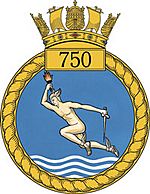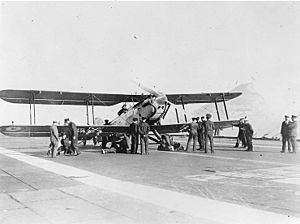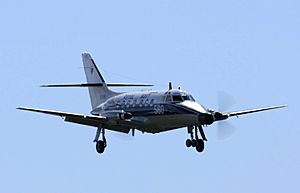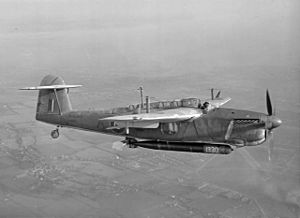750 Naval Air Squadron facts for kids
Quick facts for kids 750 Naval Air Squadron |
|
|---|---|

Squadron badge
|
|
| Active |
|
| Country | |
| Branch | |
| Type | Flying squadron |
| Role | Air observer training |
| Size | Four aircraft |
| Part of | Fleet Air Arm |
| Home station | RNAS Culdrose |
| Motto(s) | Teach and strike |
| Aircraft | Beechcraft Avenger T1 |
| Commanders | |
| Current commander |
Lieutenant Commander |
The 750 Naval Air Squadron is a special part of the Royal Navy. It trains people to be "observers" for the Fleet Air Arm. Observers are like the eyes and ears of the aircraft. They help pilots navigate and find things from the sky.
This squadron started as the Royal Navy Observer School in 1939. It was first based at RNAS Lee-on-Solent. During World War II, the squadron moved to Trinidad to keep training aircrew. It was temporarily closed in 1945. The squadron started again in 1952. Today, it is based at RNAS Culdrose in Cornwall, UK. They train about 30 Royal Navy observers each year.
Contents
Squadron History: From School to Squadron
The Royal Navy first set up a training school for seaplane pilots and observers in 1917. This was at Lee-on-Solent. In 1918, the Royal Naval Air Service joined with another group to form the Royal Air Force. The school then changed its name.
In the 1920s, the school kept training seaplane crews. It had different names, like the RAF Seaplane Training School. From 1925, the Royal Air Force provided all naval aircrew. This meant naval officers stopped training as observers for a while. The main plane used for training back then was the Fairey IIID.
By 1932, Lee-on-Solent had a full airfield. It became a main base for the RAF's Coastal Command. Observer training continued there. Many naval aircraft were based at the airfield. These included planes like the Fairey Seal and Fairey Swordfish.
World War II and Beyond
The 750 Naval Air Squadron officially formed on May 24, 1939. It was created from the Royal Navy Observer School. The squadron was first at RNAS Ford. But after Ford was bombed early in the war, it moved to RNAS Yeovilton. Even with a new name, its main job was still to train observers.
The squadron first flew Hawker Ospreys and Blackburn Sharks. In November 1940, it moved to Trinidad. There, it started using Fairey Albacores for training.
A sad event happened in January 1941. Officers and crew from 750 Squadron and others were sailing to Trinidad. Their ship, the SS Almeda Star, was sunk by a German submarine. Sadly, no one survived this attack.
The squadron stayed in Trinidad for the rest of World War II. It was closed down in October 1945. But it started up again in April 1952. This time, it was at RNAS St Merryn. They used Fairey Barracudas and Avro Ansons. In 1953, they got new planes, the Fairey Firefly T7 and Percival Sea Prince T1. That same year, the squadron moved to RNAS Culdrose.
The squadron changed its name a few times. In 1955, it became the Observer and Air Signal School. Later, it focused only on observers. It moved to Malta in 1959, then to RNAS Lossiemouth in 1965. The squadron returned to RNAS Culdrose in 1972. It kept using the Sea Prince T1 planes. These were replaced by the Jetstream T2 in 1978. In 1992, the squadron reached a special milestone. It had been active for 50 years without stopping.
What 750 Squadron Does Today
Today, 750 Naval Air Squadron trains new observers for the Fleet Air Arm. These are the people who will work as aircrew officers. They first go through basic training. Then, they join 750 NAS for seven months. Here, they learn all about flying navigation and other important skills. This training happens in classrooms, in flight, and using a computer simulator.
After this course, they are ready for advanced flying training. They will then specialize in certain aircraft. Observers often serve in Wildcat HMA2 or Merlin HM2 helicopters. These helicopters help the Navy see and hear things far out at sea. They are very important for finding and fighting enemy ships and submarines.
In 2011, the squadron changed its planes again. They replaced the Jetstreams with Avenger T1 aircraft. These are special versions of the Beechcraft King Air 350ER. The squadron uses four of these planes. They are owned by a company but used by the military. Both military and civilian staff work together to teach the students. Besides Royal Navy observers, the squadron also trains Royal Air Force aircrew.
Aircraft Flown by 750 NAS
Since 1939, 750 Naval Air Squadron has flown many different types of aircraft. Here are some of them:
- Blackburn Shark II
- Fairey Albacore I
- Fairey Barracuda II & TR3
- North American Harvard
- Avro Anson I
- Percival Sea Prince T1
- Fairey Firefly T7
- Airspeed Oxford I
- de Havilland Sea Vampire T22
- de Havilland Sea Venom FAW21 & FAW22
- de Havilland Sea Devon C20
- Handley Page (later BAe) Jetstream T2 & T3
- Beechcraft Avenger T1





